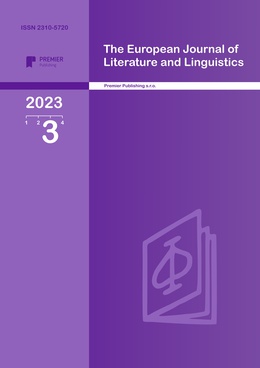THE GENRE OF THE PARABLE, ITS GENESIS, DEVELOPMENT AND CURRENT STATE
Authors
Guljakhon Bolikulovna Sharipova

Share
Annotation
This article is a study of the poetics of J. de Lafontaine's works. In it, the parable genre in fiction, the history of its genesis and development, and J. In the works of de Lafontaine, special attention is paid to the study of the relationship between nature and man, individual and society. Also, the article provides information about scientific sources that reflect the illumination of the life of animals (animals, birds) and its characteristics in the works of J. de Lafontaine. Comparative-typological analysis methods were used to clarify this problem. In France, compared to other Western countries, in the XVII-XVIII and XX centuries, the writing of works in the animalistic genre increased. According to the researchers, there are principles of "anthropological" and "zoological" direction in the French fable genre, and the anthropological direction of the fable genre can be distinguished from them: 1) direction, i.e. transfer of animal characteristics to humans (Fables of Lafontaine); 2) the direction arising from realism in highlighting the characteristics of animals, in which the direction of natural science prevails. So, the anthropological direction prevailed in fiction, the reason being that the parable is based on the folklore of a certain area, mythological elements and epic sources, or it may be completely invented by the writer. Parables are very similar in one thing: the characteristics of animals help to express and understand major events in human life. Race, class, gender, and other risks are explored through animal imagery.
Keywords
Authors
Guljakhon Bolikulovna Sharipova

Share
References:
1. Murad Togay (2010). Preface to Seton-Thompson's book.// E. Seton-Thompson. Wild diaper. Stories about animals. [Murod Togai (2010). Preface to Seton-Thompson's book.//E. Seton-Thompson. Wild quilt. Stories about animals. - T.: Publisher, 2010. - B.7].
2. Mikheeva A.P (1990). Lyricheskie dnevniki Colette. Autoref. diss. kand.fil.n [Mikheeva A.P (1990). Lyricheskie dnevniki Colette. Autoref. diss. kand.phil.n. - L., 1990].
3. Mirsaidov B.T (2004). Khudestvenny obraz ptis v mysticeskoy poezii srednih vekov (X1-XIII vv.). Autoref. dis. sugar Philol. science [Mirsaidov B.T (2004). Godly image ptis and mystical poetry of the middle ages (vv. X1-XIII). Autoref. dis. sugar Philol. science - Khujand, 2004. - P.15].
4. Orekhova Yu.S (2008). Animalisticheskaya literatura Francii: Tradisii I ix transformationa v tvorchestve S.G. Collette. Autoref. dis. sugar Philol. Nauk [Orekhova Yu.S (2008). Animalisticheskaya literatura Frantsii: Tradisii i ix transformation v tvorchestve S.G. Kollet. Autoref. dis. sugar Philol. science – Kaliningrad, 2008. – P.4]
5. Fomin S.M (1985). Tvorchesky method Sidoni-Gabriel Colette. Autoref. diss. sugar Philol. science [Fomin S.M (1985). Tvorchesky method Sidoni-Gabriel Colette. Autoref. diss. sugar Philol. science - M., 1985. – P.18].
6. Propp V. Ya. (author), Ivleva L.M. (publ., pref. and notes). Open Lecture. Zhivaya starina, 1995, no. 3, pp. 11–17. (In Russian)
7. Charpenter H (1932). Secret Garden: A Study of the Golden Age of Children's Literature. - London, 1932. - P.35.
8. Fabliaux et contes du Moyen Age. – Paris, Librairie A.Hatier, 1952.
9. Russian-Uzbek dictionary (1984). Two-roofed. T.N. [Russian-Uzbek dictionary (1984). It has two roofs. T.N. - T.: Uzbek Soviet Encyclopedia Chief Editor, 1984. - P.581]
[1]Tashkent Uzbekistan, 75PV+CG7, Tashkent 100138, Uzbekistan, E-mail-gulsara.qurbonovna@gmail.com. id, https://orcid.org/0000-0002-4698-491X


